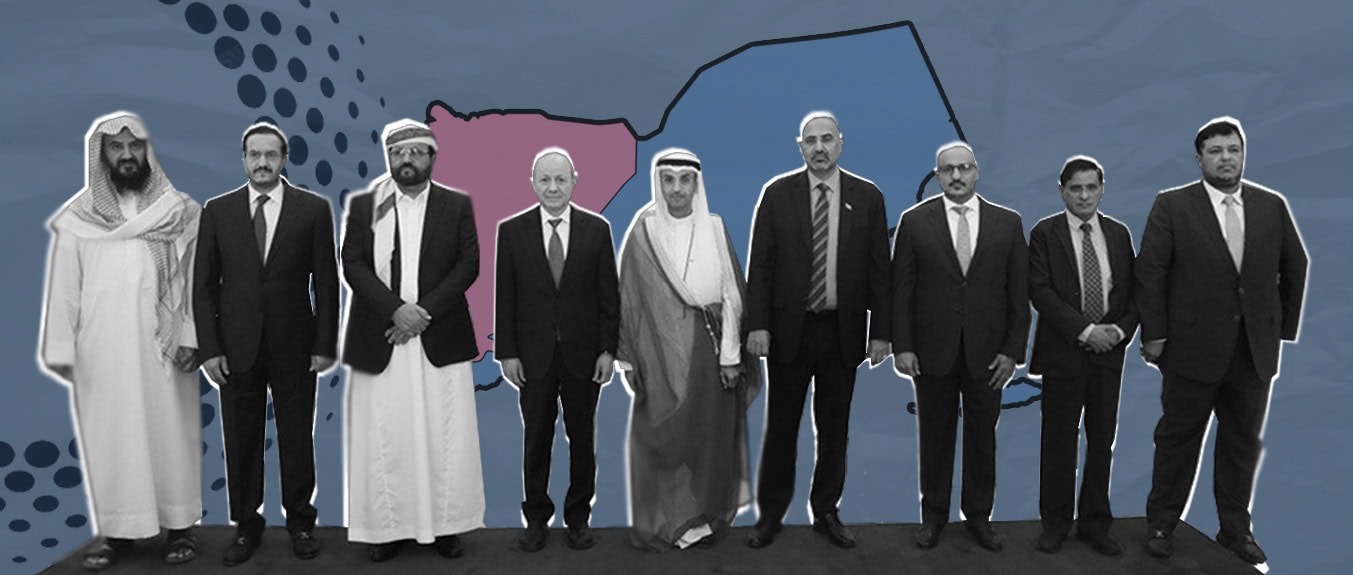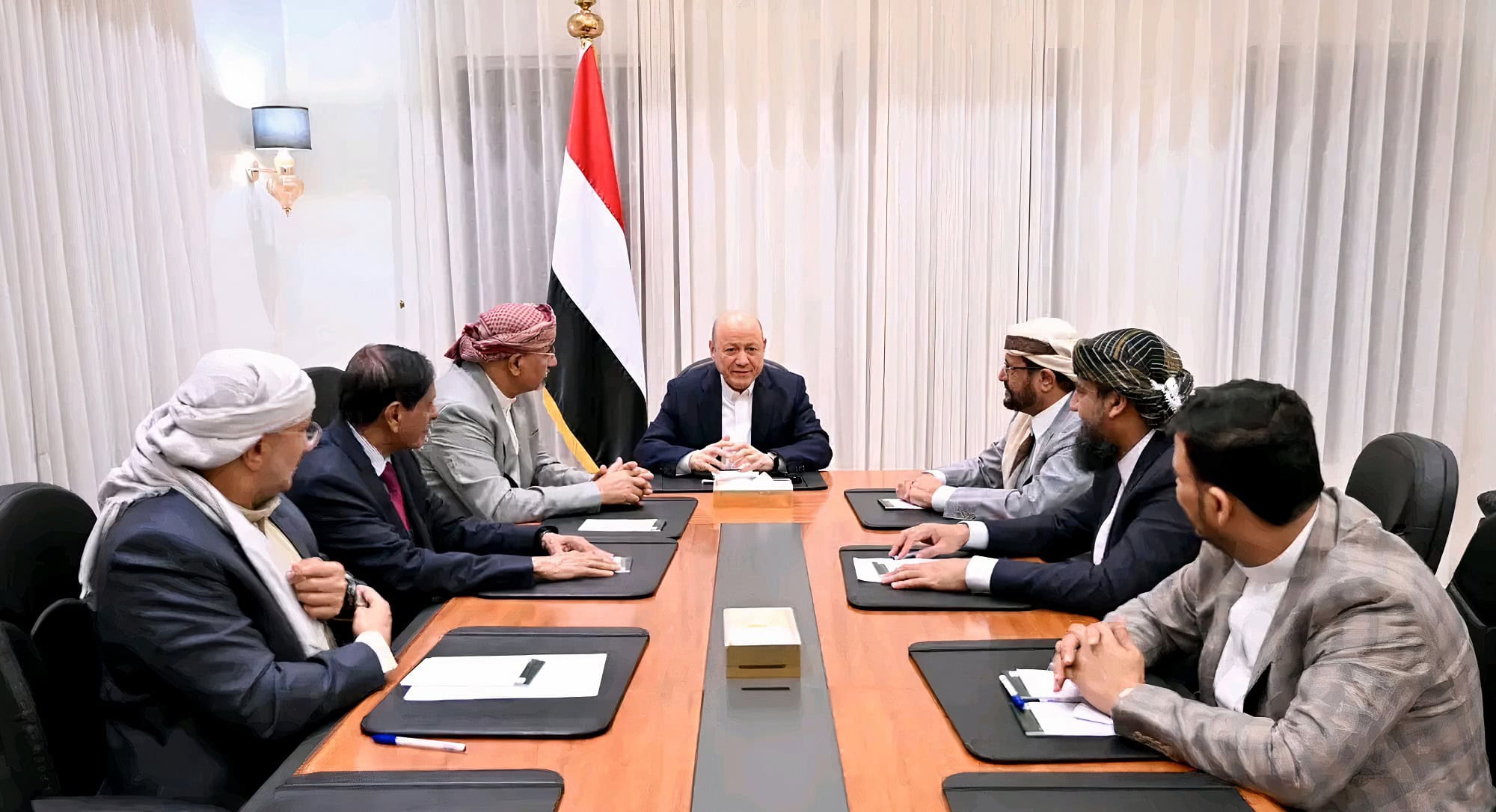
South24 Center
آخر تحديث في: 16-09-2024 الساعة 4 مساءً بتوقيت عدن
The PLC, in its current form, has proven ineffective in addressing Yemen's complex challenges, including unifying the fragmented political landscape, countering the Houthi threat, and tackling the dire economic situation.
Ala Mohsen (South24)
Introduction
When the Saudis assembled a coalition of countries to help reverse the Houthi expansion in early 2015, they did not expect the campaign would drag on for years without a decisive victory against the group, who still control Sana’a and many parts of historical North Yemen to date. Regardless of the causes of this failure, the Hadi administration, representing the Internationally Recognized Government of Yemen, bears the lion’s share of responsibility for this military debacle. Despite substantial financial and political support from its regional allies and international partners, the Hadi administration was characterized by corruption, incompetence, weak governance, and an inability to collaborate effectively with local allies and regional backers. Furthermore, despite the changing local balance of power and the rise of new powerhouses since 2015, the Hadi administration did little to incorporate these actors into its institutions. International pressures were also increasing to end Yemen’s ongoing civil war, which could only be achieved with a unified executive body capable of credibly challenging the Houthis and negotiating from a position of strength. These factors necessitated the restructuring of the IRG's authority to make it more inclusive, responsive, and effective in bringing peace and stability to the country.
Against this background, on April 7, 2022, President Abdrabbuh Mansour Hadi transferred his presidential powers to a new presidium called the Presidential Leadership Council (PLC). While the rationale for this change is well justified, the manner in which it was conducted was at least problematic. Between March 29 and April 7, 2022, Riyadh hosted intra-Yemeni talks and consultations under the auspices of the Gulf Cooperation Council (GCC). However, the outcomes of these consultations were predetermined in a top-down manner, with attendees primarily brought in to endorse and lend legitimacy to these changes. This brief 10-day period did not allow for adequate deliberation among attendees and the various political factions. Moreover, the timing of these consultations and PLC formation, which coincided with the UN-sponsored truce, suggests that the primary aim of this new political arrangement was to facilitate Saudi Arabia's exit from Yemen’s quagmire rather than to genuinely reform the IRG governance.
The PLC: Strengths and Weaknesses
Undoubtedly, the PLC reflects the local power dynamics better compared to the previous Hadi administration. The eight members of the council constitute a good representation of different regions and political factions: four Southern members (Aidrous Al-Zubaidi, Abdulrahman Al-Muhrrammi, Faraj Al-Bahsani and Abdullah Bawazir,) and four Northern members (Rashad Al-Alimi, Sultan Al-Aradah, Tariq Saleh and Othman Megali). This composition captures the country's political landscape and includes various political groups, such as the General People's Congress (GPC), Islah party, and the Southern Transitional Council (STC). This inclusive arrangement has led to a significant reduction in armed conflict in the anti-Houthi coalition.
Despite this partial success in reducing conflict, the council has yet to deliver on its key responsibilities and rectify its shortcomings. The PLC remains paralyzed by internal divisions and conflicting agendas. As a result, the PLC has not been successful in neutralizing the Houthi threat in the Yemeni territories or the surrounding waters. The Houthis were able to target multiple oil ports in areas under PLC control. The most significant among those is the attack on the Al-Dabba oil terminal in Hadramout in October 2022 a few months after the PLC's formation. These attacks on ports have effectively prevented the government from exporting crude oil, leading to a significant reduction in state revenues. Meanwhile, the Houthis persist in their aggressive tactics, employing new weaponry to strike at their adversaries, while the PLC, much like the former Hadi administration, remains confined to a defensive position.
One of the main objectives of the PLC was to unite the various anti-Houthi forces and provide a coordinated military response. However, this goal remains unfulfilled. The council has failed to integrate Yemen's diverse anti-Houthi armed groups into a single command structure, leaving them fragmented and unable to mount a cohesive military strategy. As a result, the Houthis have grown stronger, as demonstrated by their Red Sea maritime attacks and increasing military capabilities. Deepening discord has even led to the establishment of new military forces, with reports suggesting that Rashad Al-Alimi has sought to deploy the Saudi-funded Nation Shield Forces to counteract the UAE-supported pro-STC forces. On the governance and economic front, the PLC has also been ineffective in alleviating people’s suffering, failing to stabilize local currency or control hyperinflation.
Problems of Consociationalism
The PLC represents an attempt at consociationalism in Yemen, as it is designed to promote power-sharing and consensus-building to manage the country's deeply divided political spectrum. However, we must be mindful of the drawbacks of such representative systems, which often fall victim to gridlock and elite dominance. Gridlock often leads to political paralysis in major decisions, while elite dominance results in excessive focus on elite bargaining, often at the expense of grassroots needs. The PLC grapples with these issues, yet there are no apparent efforts to mitigate those negative effects. The council's deep divisions have made it impossible to function effectively as Yemen's top executive body. Despite official assurances that the PLC operates as a unified body, significant divisions persist among its members. Recently, Faraj Al-Bahsani, Vice President of the STC and member PLC, openly criticized PLC Chairman Rashad Al-Alimi's efforts in Hadramout, arguing that such actions dilute the governorate’s issues, waste time, and demonstrate a lack of seriousness in addressing local concerns.
While divisions and differences are expected in a consociational arrangement, the lack of clear rules and regulations defining the roles, responsibilities, and limits of each member's authority has hindered the effectiveness of the PLC operations. For instance, senior STC official Nasser Al-Khobagi has accused the PLC Chairman Rashad Al-Alimi of making unilateral decisions without consulting other council members. Similarly, VP Abdulrahman Al-Muhrrammi closed a newly opened office affiliated with the PLC Chairman's secretary, Yahya Al-Shuaibi, to protest the unilateral restructuring decisions made without PLC consensus. These incidents arise from the lack of a clear operational mechanism for the PLC.
The Need for a New Governing Structure
Given the PLC’s inherent flaws, it is evident that a major overhaul of the council is necessary to address past mistakes. Due to its large membership, the PLC has faced significant challenges in governing the country and bringing the Houthis to peace. Thus, the existing council should be replaced with a smaller governing structure that reflects Yemen’s current political realities and simplifies the policy-making process. A three-member structure would be more effective than the current eight-member council. This compact council would consist of one president and two vice presidents—one representing the South and the other representing the North. The integration of PLC members Abdulrahman Al-Muhrrammi and Faraj Al-Bahsani into the STC underscores the political significance of the South-North divide. Each vice president would manage the affairs of their respective regions, while the president would serve as a symbolic figure to bridge regional divides. This proposed arrangement would simplify decision-making while respecting regional sensitivities within the country.
A smaller three-member council offers several advantages. First, by minimizing the number of council members, we are going to have fewer conflicting interests and a more streamlined council. This, in turn, will reduce gridlock, making decision-making and policy implementation more efficient. Even for the PLC Chairman, dealing with two VPs is also more manageable than coordinating with seven at the same time. Second, the streamlined structure will establish clearer lines of authority and command, reducing confusion and inefficiencies. Relatedly, the smaller council structure will improve accountability by making it easier to track decisions and their implementation. With fewer members, it will be clearer who is responsible for each decision, ensuring that each council member, including the president, has a well-defined role and area of expertise. This way, it will be easier to hold individuals accountable for their actions. Finally, this simplified structure is likely to improve collaboration with regional backers. Saudi Arabia’s historical ties to North Yemen and the UAE’s close relationship with the STC can strengthen the council, making balanced regional influence a cornerstone of its stability.
Conclusion
The PLC, in its current form, has proven ineffective in addressing Yemen's complex challenges, including unifying the fragmented political landscape, countering the Houthi threat, and tackling the dire economic situation. Although it has provided greater representation and has reduced armed conflict between the anti-Houthi coalition partners, it has not been able to bring the Houthis to peace, nor was it able to stabilize the regions under its control. The PLC’s large membership has hindered its ability to function as a unified governing executive, exacerbating power struggles and leading to mutual accusations and internal conflicts among its members. Immediate action is crucial to prevent the PLC's collapse, especially with the potential withdrawal of key stakeholders from this coalition government. Currently, the STC is under increasing pressure from its grassroots, who are frustrated by the lack of government action to address the decline in services and the worsening economy. To move Yemen toward peace and stability, a more streamlined governing body is needed to command the dual tasks of pressuring the Houthis militarily and bringing stability to the liberated areas.
Non-resident researcher at South24 Center, a doctoral researcher in political science at the University of Utah.

قبل 3 أشهر